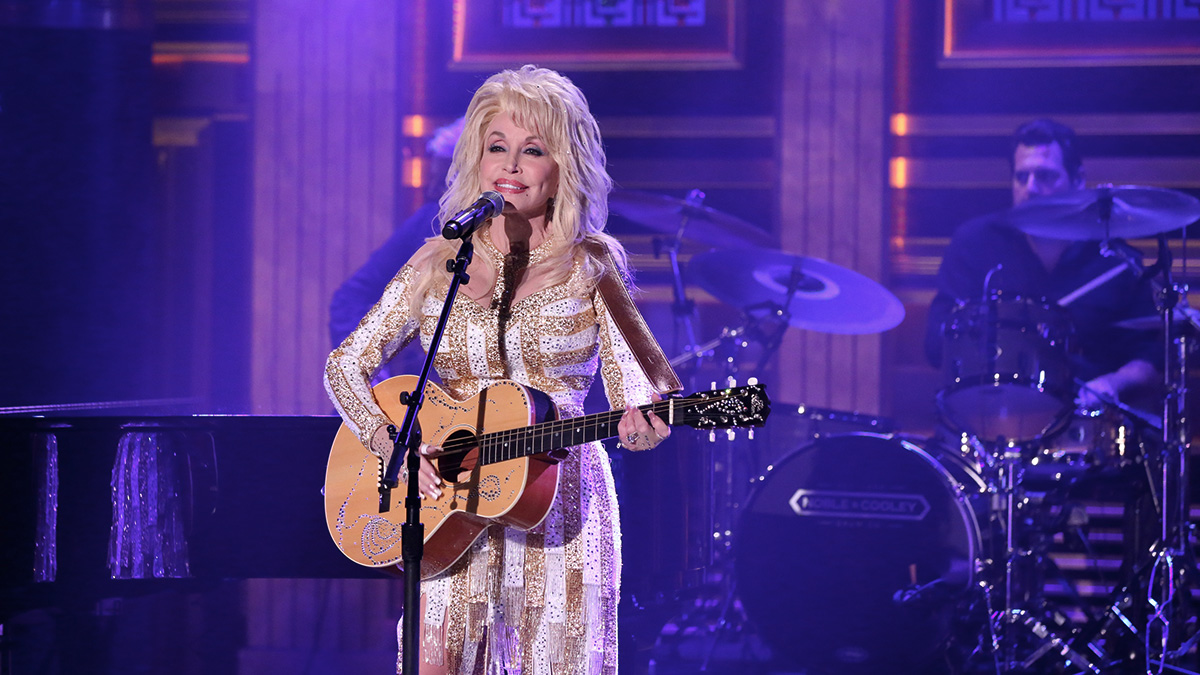Country icon Dolly Parton has written over 3,000 songs, but her trademark ‘thumb and flick’ playing style is essential learning for acoustic players
Develop your alternating bassline picking and bluegrass soloing techniques with this country rhythm workout

The long-reigning queen of country, Dolly Parton’s career is astonishing when you put it into numbers: over 3,000 songs penned including mega-smash I Will Always Love You, made doubly famous by Whitney Houston in the film The Bodyguard.
A true crossover artist, Dolly has taken country into the mainstream charts with hits Jolene and 9 To 5, which many a function guitarist will have had to master.
Dolly’s glittering, rhinestone-laden onstage image belies her humble beginnings. She was born in Tennessee and raised in a one-room shack, but music proved to be an early way out of poverty. By age 10, she was performing on local radio and, staggeringly, by 13 she was appearing on the legendary Grand Ole Opry stage.
After leaving school the obvious move was to Nashville where she became a professional songwriter, penning hits for other artists and raising her profile with weekly appearances on country star Porter Wagoner’s TV show.
She gained her first big hits duetting with Wagoner before going solo and earning success with 1973’s chart-topper Jolene, and I Will Always Love You which hit the top spot in 1974 (again in 1984) and her first Grammy in 1979.
As with many artists in the country and pop worlds, the parts you hear on record are typically played by studio musicians. However, watch Dolly live and she plays guitar, banjo and dulcimer.
While her guitar playing usually serves the role of simple accompaniment – largely due to her long fingernails, which shaped her entire six-string style – she will often play short, bluegrass-inspired solos the like of which I’ve included here. It’s a great example of melodic, scale-based country playing and is a good way into the genre if you are new to it.
Dolly’s playing is driven by the Maybelle Carter-style ‘thumb and flick’ approach and the Hank Williams/Johnny Cash alternating bassline style. You can play this with a pick but if you opt for the Carter style then the picking-hand thumb plucks a bass note followed by the first finger flicking down to sound the corresponding chord. Aim to strike the strings with the nail on the finger for a more percussive characteristic.
While there are few demands on the fretting hand here, as Dolly mostly plays simple open-position chords, you may find the picking-hand thumb needs some work so as to ensure you strike the correct bass notes. For the first-finger flick, make sure you have sufficient power to strike the strings but not so much that they overshadow the bass notes. It’s a balancing act between thumb and finger to get this sounding right.
Get the tone
Amp settings: Gain 3, Bass 7, Middle 6, Treble 7, Reverb 2
You will often see Dolly perform with her custom Taylor GS Mini and her Martin 5-18 Terz – she is a fan of small-scale three-quarter acoustic guitars. Typically within this style, though, you’ll want to use a larger bodied instrument, although of course this isn’t vital. I recorded this lesson with a Martin Custom Expert 1937 D28 and a Soyuz 017 fet microphone.
Playing notes
[Bars 1-16] Classic country strumming is very easy on the surface, but there are elements that make it a challenge.
Timekeeping is the obvious one, but you also have to be really accurate with the alternating bass notes otherwise things start to sound uneven, and if you catch the wrong string you will really hear it!
All of this becomes even more real when you perform this stuff with a bassist as they will typically be playing the same basslines as you, albeit in a lower register.
[Bars 17-32] Dolly has a great and practical approach to soloing that just works – she generally builds licks around chord shapes, in this case triads. Using this method means you can’t really go wrong as you are always hitting chord tones (root, 3rd, 5th, etc).
Add the typical country/bluegrass rhythmic phrasing of mostly quavers and crotchets along with some legato (hammer-ons and slides in this case) and you have the perfect melodic country solo.
Get The Pick Newsletter
All the latest guitar news, interviews, lessons, reviews, deals and more, direct to your inbox!
Stuart Ryan is best known for his acoustic guitar playing, from Celtic fingerpicking and traditional folk to modern percussive phrasing and fresh interpretations of popular pieces. He has released several solo albums, written pieces for UK examination boards and created nine tutorial books ranging from acoustic guitar arrangements to Americana styles.
“There are so many sounds to be discovered when you get away from using a pick”: Jared James Nichols shows you how to add “snap, crackle and pop” to your playing with banjo rolls and string snaps
Don't let chord inversions bamboozle you. It's simply the case of shuffling the notes around








![Joe Bonamassa [left] wears a deep blue suit and polka-dotted shirt and plays his green refin Strat; the late Irish blues legend Rory Gallagher [right] screams and inflicts some punishment on his heavily worn number one Stratocaster.](https://cdn.mos.cms.futurecdn.net/cw28h7UBcTVfTLs7p7eiLe.jpg)


